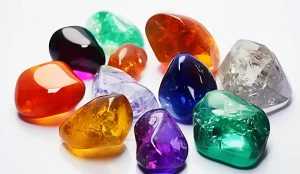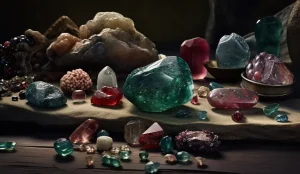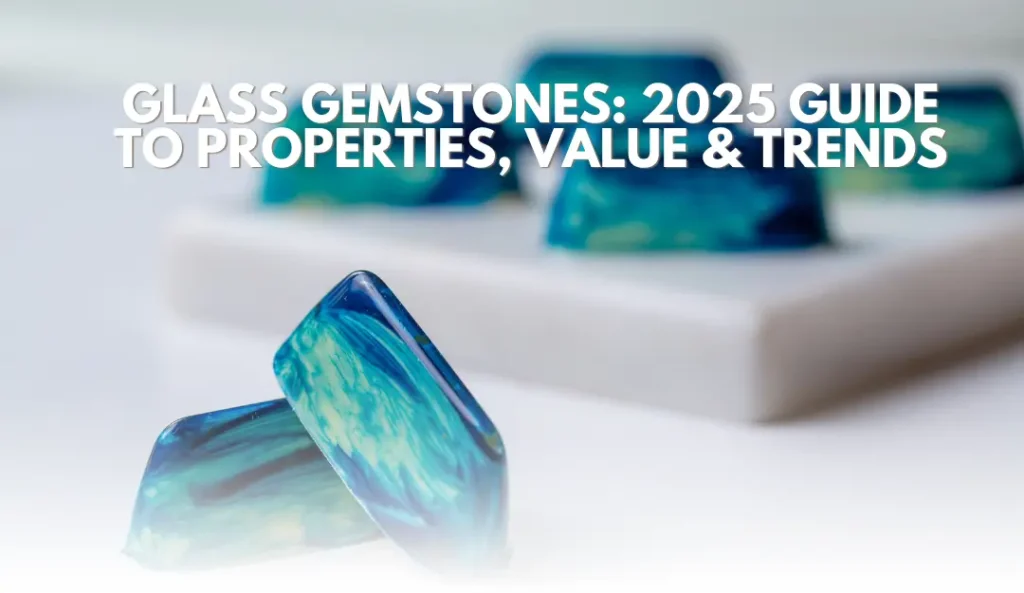Glass gemstones have fascinated jewelry designers for centuries, providing a stunning and versatile alternative to traditional precious stones. Celebrated for their affordability, visual appeal, and ability to imitate rare gemstones, glass gemstones continue to captivate both enthusiasts and designers alike. In this guide, jewelry expert Ramil Abalkhad, with decades of experience, explores the fascinating world of glass gemstones, their properties, value, and the latest trends shaping the industry in 2025.
What Are Glass Gemstones?
Glass gemstones are semi-precious stones primarily made from silica-based materials. They have a rich history, dating back to ancient civilizations such as the Egyptians and Romans, who used glass beads and pendants in their jewelry. While some may consider glass gemstones mere imitations, Ramil Abalkhad emphasizes that they are artistic creations in their own right. “Glass provides a medium for designers to explore vibrant colors, intricate shapes, and captivating effects that are often impossible with natural stones,” he says. visit :
Properties of Glass Gemstones
Glass gemstones are known for their stunning and adaptable qualities, which make them a favorite choice for jewelry designers. Here’s a breakdown of the key characteristics that define glass gemstones:
- Composition: Glass gemstones are primarily made of silica (SiO2), with additives like soda, lime, and lead to enhance their brilliance and durability.
- Hardness: They typically range from 4.5 to 7 on the Mohs scale, meaning they are durable but can still be scratched.
- Colors: Glass gemstones come in a wide variety of colors, including multi-colored and iridescent varieties.
- Optical Effects: Glass gemstones can replicate unique optical phenomena such as asterism, chatoyancy, and aventurescence, effects often seen in natural gemstones.
With technological advancements, modern glass gemstones now feature nano-coatings that enhance their iridescence and durability, which has led to an increase in their popularity. As Ramil Abalkhad explains, “These innovations make glass gemstones even more captivating in 2025.”
Types of Glass Gemstones

Glass gemstones can be categorized into two main types: natural and man-made.
1. Natural Glass Gemstones
These stones form through natural processes, such as volcanic activity or meteorite impacts. Some well-known examples include:
- Obsidian: A black, glassy volcanic rock.
- Tektite: Formed from meteorite debris, with moldavite being the most famous variety.
- Fulgurite: Created when lightning strikes sand or rock.
2. Man-Made Glass Gemstones
These glass gemstones are typically crafted to imitate natural stones or as unique, standalone creations. Popular varieties include:
- Goldstone: A glass with copper or gold inclusions that create a sparkling effect, known as aventurescence.
- Opalite: A milky, opalescent glass often used as a simulant for moonstone.
- Aurora Borealis (AB) Glass: Famous for its iridescent coating, first developed by Swarovski in 1956, this remains a hot trend in 2025.
- Sea Glass: Weathered by the ocean, sea glass has a frosted appearance and is prized for its eco-friendly appeal.
Ramil Abalkhad notes that man-made glass gemstones have become increasingly sophisticated. “Techniques like laser etching and 3D molding are pushing the boundaries of design, allowing glass gemstones to rival natural stones in complexity and beauty,” he explains.
How to Identify Glass Gemstones
Glass gemstones can closely mimic natural stones, but there are a few ways to distinguish them:
- Inclusions: Glass may contain bubbles or swirl marks visible under magnification.
- Temperature: Glass gemstones tend to feel warmer to the touch compared to most natural stones.
- Surface Texture: Man-made glass stones may display an “orange peel” texture or mold marks.
Ramil advises that when in doubt, consult a trusted jeweler or gemologist to verify the authenticity of a gemstone, especially for high-end pieces.
Glass Gemstone Jewelry Trends in 2025
In 2025, the jewelry industry is embracing glass gemstones like never before. Key trends include:
- Sustainable Jewelry: Glass made from recycled materials, particularly sea glass, is gaining popularity as consumers become more eco-conscious.
- Custom Designs: New glass-cutting technologies enable intricate, personalized designs that are tailored to individual tastes.
- Iridescent Finishes: AB glass and other iridescent varieties are taking over the fashion runways, adding a magical, multi-colored shine to designs.
- Vintage Revival: Antique glass gemstone jewelry, including pieces from the Victorian era or Art Deco period, is making a comeback.
According to Ramil Abalkhad, “In 2025, designers are increasingly combining glass gemstones with precious metals and natural stones, creating unique, one-of-a-kind pieces that merge tradition with modernity.”
Caring for Glass Gemstone Jewelry
While glass gemstones are relatively low-maintenance, proper care ensures they retain their beauty and longevity:
- Cleaning: Gently clean glass gemstones with lukewarm water, mild soap, and a soft cloth. Avoid using harsh chemicals or ultrasonic cleaners.
- Storage: Keep glass gemstones separate from harder stones to prevent scratching.
- Handling: Treat glass gemstones with care, as they can chip or shatter if dropped.
Ramil emphasizes that with the right care, glass gemstone jewelry can last for generations, becoming timeless heirlooms. visit :
Spotting Fake Gemstones: by Ramil Abalkhad
The Value of Glass Gemstones

While glass gemstones are generally more affordable than natural gemstones, their true value lies in their craftsmanship and design. Rare natural glass stones, such as moldavite and obsidian, can command higher prices due to their rarity. Man-made varieties like goldstone and opalite remain accessible but are prized for their unique visual effects and versatility.
As Ramil Abalkhad observes, “In 2025, antique glass jewelry—particularly pieces from the Art Deco or mid-century modern eras—has become highly sought after by collectors.”
Frequently Asked Questions (FAQ)
1. Are glass stones worth anything?
Yes, glass stones can be valuable, especially when they are rare, antique, or feature exceptional craftsmanship. Natural glass gemstones like moldavite and obsidian tend to be more valuable, while man-made varieties like goldstone and opalite remain budget-friendly.
2. Can glass gemstones be worn as pendants?
Absolutely! Glass gemstones are ideal for use in pendants due to their lightweight nature and striking visual appeal. They can be cut into various shapes and sizes, making them suitable for both statement pieces and delicate designs.
3. How can I tell a real gemstone from glass?
To identify whether a gemstone is glass or natural, consider:
- Inclusions: Glass often contains round bubbles or swirl marks.
- Temperature: Glass feels warmer to the touch.
- Hardness: Glass is softer and more prone to scratching than many natural stones.
- Surface Texture: Glass may display mold marks or an “orange peel” texture.
4. What are glass gemstones called?
Glass gemstones go by various names depending on their type:
- Goldstone: A glittering glass with metallic inclusions.
- Opalite: A milky, opalescent glass.
- Sea Glass: Weathered glass with a frosted appearance.
- Aurora Borealis (AB) Glass: Iridescent-coated glass.
Conclusion: The Timeless Appeal of Glass Gemstones
Glass gemstones represent centuries of human creativity, innovation, and craftsmanship. From ancient Egyptian glass beads to cutting-edge 2025 designs, glass continues to be a powerful medium for self-expression in jewelry. As Ramil Abalkhad concludes, “Glass gemstones offer endless possibilities, combining affordability with artistic beauty, making them a brilliant choice for any jewelry lover.”
With technological advances and a growing emphasis on sustainability, glass gemstones are poised to shine even brighter in 2025, providing timeless elegance and beauty for the modern world.

